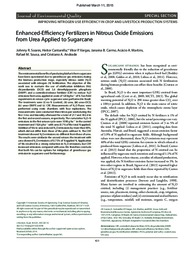Enhanced-efficiency fertilizers in nitrous oxide emissions from urea applied to sugarcane.
Enhanced-efficiency fertilizers in nitrous oxide emissions from urea applied to sugarcane.
Author(s): SOARES, J. R; CANTARELLA, H.; VARGAS, V. P; CARMO, J. B. do; MARTINS, A. A; SOUSA, R. de M.; ANDRADE, C. A. de
Summary: Abstract: The environmental benefits of producing biofuels from sugarcane have been questioned due to greenhouse gas emissions during the biomass production stage, especially nitrous oxide (N2O) associated with nitrogen (N) fertilization. The objective of this work was to evaluate the use of nitrification inhibitors (NIs) dicyandiamide (DCD) and 3,4 dimethylpyrazole phosphate (DMPP) and a controlled-release fertilizer (CRF) to reduce N2O emissions from urea, applied at a rate of 120 kg ha?1 of N. Two field experiments in ratoon cycle sugarcane were performed in Brazil. The treatments were (i) no N (control), (ii) urea, (iii) urea+DCD, (iv) urea+DMPP, and (v) CRF. Measurements of N2O fluxes were performed using static chambers with four replications. The measurements were conducted three times per week during the first 3 mo and biweekly afterward for a total of 217 and 382 d in the first and second seasons, respectively. The cumulative N2O?N emissions in the first ratoon cycle were 1098 g ha?1 in the control treatment and 1924 g ha?1 with urea (0.7% of the total N applied). Addition of NIs to urea reduced N2O emissions by more than 90%, which did not differ from those of the plots without N. The CRF treatment showed N2O emissions no different from those of urea. The results were similar in the second ratoon: the treatment with urea showed N2O emissions of 0.75% of N applied N. Application of NIs resulted in a strong reduction in N2O emissions, but CRF increased emissions compared with urea. We therefore conclude that both NIs can be options for mitigation of greenhouse gas emission in sugarcane used for bioenergy.
Publication year: 2015
Types of publication: Journal article
Unit: Embrapa Environment
Observation
Some of Embrapa's publications are published as ePub files. To read them, use or download one of the following free software options to your computer or mobile device. Android: Google Play Books; IOS: iBooks; Windows and Linux: Calibre.
Access other publications
Access the Agricultural Research Database (BDPA) to consult Embrapa's full library collection and records.
Visit Embrapa Bookstore to purchase books and other publications sold by Embrapa.

